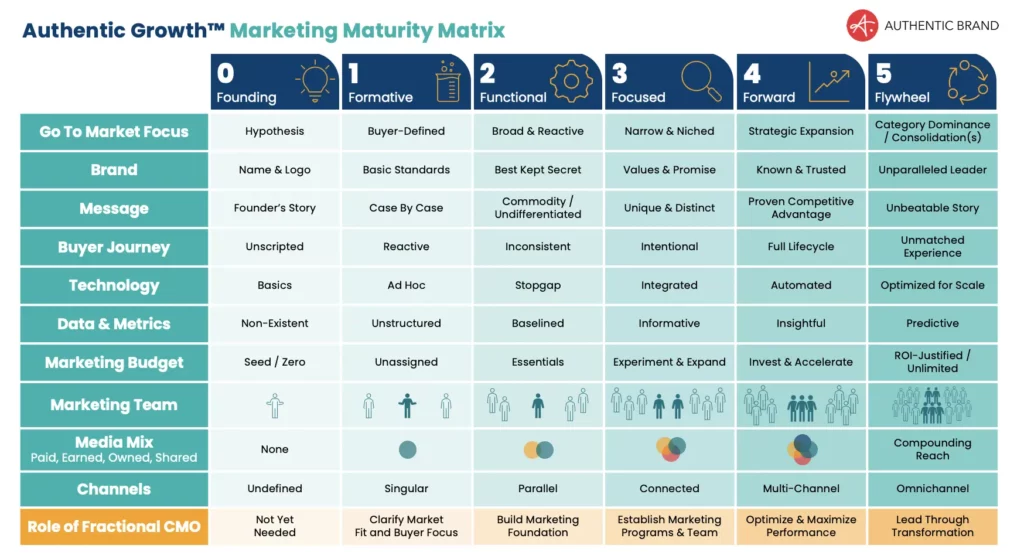
Marketing team: cost or investment?
Many entrepreneurial organizations put off hiring marketing leadership or internal roles until it becomes painfully, undeniably necessary. Instead of investing in strategic marketing early on, founder-led, sales-driven organizations often cobble together what they need to support sales, create market traction, and develop operational critical mass. Marketing is often considered a cost instead of an investment. As a result, the earliest iterations of the marketing function lack clarity and structure, and the makeshift team is likely committing random acts of marketing.
But there comes a time in every growth-driven business when leaders recognize the need to establish a true strategy, backed by a marketing team equipped to achieve their objectives. However, without an experienced marketer to guide the hiring process, it can be challenging to know who to hire, for what capabilities, in what order, and at what level.
After all, the number of tactics, tools, and channels used in marketing — and the skill sets needed for each — continues to change and expand rapidly. We often see businesses make their best guess at the type of marketers they think they need and then invest time, money, and energy into hiring them— only to realize they made the wrong hires and wasted resources in the process.
Using our Authentic Growth™ Marketing Maturity Matrix, we demonstrate the typical stages of marketing team maturity. And while these stages may be typical, they certainly aren’t meant to be prescriptive. We often help organizations accelerate strategic impact by engaging an experienced fractional CMO sooner rather than later. Having dedicated marketing leadership at an earlier stage helps to ensure that other resources — whether external agencies and freelancers or internal full-time hires — are aligned to the strategy, vetted for the right expertise, and coordinated in their efforts.

The path to a fully-resourced department: Stages 0 to 5
Every business wants to evolve from a founder-led, makeshift marketing approach to a fully-resourced, strategically aligned marketing team. The journey to this stage requires deliberate progression, guided by insightful leadership, clear responsibilities, and a strong understanding of strategic marketing.
The following six stages demonstrate how a company typically moves through the progression of marketing team maturity.

Stage 0: Founding – Founder-Led
When a business is first starting, there’s typically no in-house marketer or marketing team. Instead, the responsibility of marketing often falls to one of the founders or a sales leader to articulate the brand’s story and manage the company’s earliest brand assets. As specific marketing needs arise, that person tackles whichever tactics the company needs to execute or finds the external resource (e.g., agency, freelancer) who can do it for them.
How to mature to the next stage: As you build the team, ask yourself who in the organization is the best person to own marketing based on their prior experiences, even if they’re not a marketer. Designate this person to take the lead on marketing. Assigning the responsibility of marketing to one person creates clear accountability and centralizes decision-making.
What you’ll need: A team of people with different strengths and capabilities who can wear the multiple hats required in the early stages of a business and a willingness to shift these hats as you continue to mature and hire.

Stage 1: Formative – Designated
There’s still no marketing team at this stage, but someone is designated to marketing. However, it’s only one of the many hats this person wears; they’re not likely a marketer by trade, nor is that their primary role in the business.
This designated “marketing lead” likely operates with little to no proactivity or strategic marketing plan and instead focuses on getting things done more reactively, as needs arise. Execution on marketing tactics usually involves partnering with one or more outside resources, like a digital agency, freelance writer, or graphic designer. The primary responsibility of your designated “marketing lead” is to be at the helm of these external resources to coordinate various projects.
How to mature to the next stage: Partner with specialized external resources to execute the marketing activities you think will best support the business. Look for indicators of what’s working and what’s not, and adjust your resources — including the partners you work with — accordingly.
What you’ll need: One or more external resources helping your designated “marketing lead” execute marketing tactics and activities.

Stage 2: Functional – First Hire
This stage often coincides with when a business has successfully brought something to market, gained a clearer understanding of its ideal customer, and is ready to invest some money to create more demand. With business ramping up, the designated “marketing lead” doesn’t have the capacity to manage more marketing activities. They need to focus more on their actual job (e.g., sales, operations). This is often when businesses decide that it’s time to hire a marketer.
It’s at this inflection point that we often see companies make poor hiring decisions: they look for an early-stage marketer with two to five years of experience, but they expect them to be able to do all things marketing related and achieve objectives usually assigned to experienced strategic marketers (e.g., build brand equity, drive brand awareness, manage multichannel marketing programs, drive revenue). Expectations are too high. No marketer, even the most experienced marketer, can possibly do all things well. As a result, marketing continues to be random as the marketer scrambles to field tactical requests that fly at them from all directions. The business is frustrated by the lack of results, and the marketer is frustrated that they don’t have support or strategic guidance.
How to mature to the next stage: Recognize that you don’t know what you don’t know when hiring, equipping, and developing marketing team members. If you’re going to build an internal team, you will need input from a leader who’s built marketing teams before and knows which skill sets to hire in-house and which you should augment with external resources.
Assess your in-house leadership capabilities and hire a marketing leader if you have a gap. Keep in mind that you don’t need to make this a full-time role. A fractional CMO can provide the strategic guidance and management that your business needs, on a part-time, flexible basis as you scale. Your marketing leader — whether part time or full time — will create a resourcing plan that identifies what level and type of in-house capabilities you need. Often, the first full-time role should be a marketing coordinator or generalist who can operate as an agile project manager to maximize the value of the freelancers, contractors, and agencies you work with. Ideally, this marketing coordinator could learn, grow, and advance in the organization with the right framework, coaching, and development from the marketing leader. We’ve seen this combination — a marketing leader paired with a coordinator — work as a dynamic duo for businesses of all types and sizes.
What you’ll need: An experienced marketing leader, like a fractional CMO, supported by a marketing manager or coordinator and specialized agency or contracted resources. You’ll also need an appreciation for the strategic role of marketing and the value of “been-there, done-that” leadership that will help you to de-risk your investments and accelerate impact.

Stage 3: Focused – Team-Building
At this stage, you have a marketing leader in place and at least one marketing coordinator managing projects and coordinating external resources. Multiple marketing programs are running, and you’re getting smarter about your ideal audience, marketplace, and value proposition. As a result, you’re beginning to identify which programs are foundational to your marketing plan and which are shorter-term initiatives or projects. Understanding this helps you determine which additional resources make sense to hire in-house and which should continue to be contracted or handled by agency partners.
For example, if content marketing is essential for your marketing strategy, you may need to hire an in-house content strategist and writer. Meanwhile, you know redesigning your website is on the horizon, but you don’t need a full-time web developer on staff because there aren’t enough day-to-day needs to justify the hire. Instead, you’ll look for a web design and development agency to partner with you flexibly when needed.
How to mature to the next stage: Start proactively resource planning, thinking about which programs are foundational to your marketing plan and need to be supported by in-house employees and which pieces you need to augment on a project basis with external resources, like agencies and freelancers.
What you’ll need: A marketing methodology driven by a strong leader who can coach earlier-stage marketing employees on strategic decision-making, equip them with the tools they need for success and alignment, and help them measure and see the impact of their work.

Stage 4: Forward – Resource Planning
At this stage, you’re mapping out the future state of your marketing team — defining which roles, at what compensation levels, and at what capacity will support the organization going forward. You’re charting when you’ll hire new employees, criteria for promoting current employees, and how these staffing decisions may change the nature of your existing agency and freelance relationships. Your marketing leader will also be continually assessing which contracts you have in place that you may need to modify to make space for your next hire. As your team grows and roles evolve, it’s important to ensure the proper levels of collaboration and overlap between roles.
The work in this stage is a dance of managing existing resources, commitments, and relationships with the pace of change, transition, hiring, and onboarding you want to do internally. It also becomes an exercise in risk management; every internal hire is a significant investment in a person who plays a critical role in your marketing organization.
How to mature to the next stage: Plan for talent management; how are you coaching and investing in the continuous training of your team? You need a budget not just for hiring employees but also for retaining them through investments in their professional development. Think through the contingencies of what would happen if an employee left your organization or didn’t end up being the right fit; do you have relationships with other resources you could call upon in those scenarios so you don’t lose marketing momentum?
What you’ll need: Career progression plans for the employees you want to keep in your organization, plus a professional development budget to invest in them. If you’re working with a fractional marketer, work with them to help you define what you need in a full-time marketing leader and create a plan for hiring that leader by either promoting internally or going to market with a job description.

Stage 5: Flywheel – Fully-Resourced
At this stage, your team is operating like a well-oiled machine, and you have a full-time, dedicated marketing leader. Everyone is aligned and motivated, delivering results, and aware of their career trajectory in the organization. As you grow, it’s critical to continue providing this level of career support at scale, dedicating additional resources to ongoing training and development. This same goes for your marketing leader; this can be a lonely seat that should also be nurtured and supported. Investing in a coach or mentor for your leader can improve their performance and increase their job satisfaction— helping to retain them.
That said, understand that not every business can offer unlimited growth opportunities for every marketer. If a team member has maximized their growth potential in your organization, the best way to support them is to help elevate them into their next role. This honest approach benefits the individual and fosters a culture of growth and honesty within the company.
How to continue maturing: Keep evaluating what’s essential to have in-house, how the world is changing, and what resources you’ll need. Stay agile with the changing marketing landscape. As new technologies emerge, like AI, businesses should ensure their teams understand how to utilize these tools effectively. Continuously evaluate whether it makes sense to keep certain marketing capabilities in-house or to outsource them.
Build an aligned, accountable, and strategic team
Even the most capable marketers can flounder in their roles without strategic support and guidance from a leader. Marketing teams that pair an experienced marketer with agile project managers and coordinators and the right mix of external resources will scale more effectively and confidently. Building a marketing team with a strategic leader at the helm of these hiring decisions is a critical step in business maturity and growth.
At Authentic, we work with our clients to instill strategic decision-making, alignment, and accountability into their marketing teams— helping clients bridge competency gaps and equipping their teams for success. Reach out if you’d like to learn how an Authentic Fractional CMO™ could bring our proven methodology to your business to build a fully-resourced marketing team.








